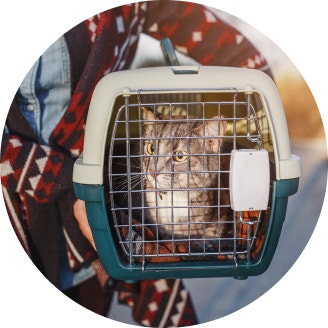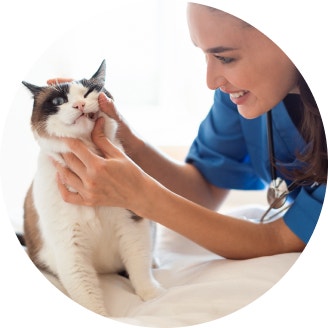Adoption Checklist
Keep track of the next steps in your adoption journey and get access to helpful resources
Schedule a Time to Meet the Pet
- Verify shelter hours and whether you need an appointment.
- Research the pet’s individual background and breed traits/needs.
- Prepare questions for the shelter and know what to expect upon arrival. We have tips on questions for dogs and cats, including items about behavior, medical history, dietary needs, interaction time at visit, etc.
Finalize the Adoption
- Sign the adoption contract and pay the adoption fee.
- Check to see what treatments and vaccines have already been administered for the animal, including procedures like spaying or neutering.
- Collect your new pet’s existing documents and personal belongings, like medical records, microchip information, toys, remaining food, etc.
Get Ready to Bring Your Pet Home
- Use a secure carrier, leash, or harness for safe transportation.
- Pet-proof your home. Kick things off with this handy list of items to secure or keep away from pets:
- Dogs
- Baby gates – Block off restricted areas (stairs, kitchens, etc.)
- Cord organizers or covers – Prevent chewing on electrical cords
- Cabinet locks – Keep your dog out of cleaning supplies or food
- Trash can with secure lid – Prevent digging through garbage
- Outlet covers – Especially useful for curious puppies
- Non-slip rugs or mats – Help prevent slips and protect floors
- Dog-safe cleaning supplies – Avoid toxic ingredients
- Chew toys – Redirect chewing from furniture or shoes
- Crate or dog-safe area – A secure place when unsupervised
- Furniture covers – For shedding or muddy paws
- Remove toxic plants – Like lilies, aloe, pothos, etc.
- Hide small objects – Things like rubber bands or hair ties can be swallowed
- Secure heavy items – Prevent tipping over when your dog jumps or plays
- Cats
- Baby gates – Block off restricted areas (stairs, kitchens, etc.)
- Cord organizers or covers – Prevent chewing on electrical cords
- Cabinet locks – Keep your cat out of cleaning supplies or food
- Trash can with secure lid – Prevent digging through garbage
- Outlet covers – Especially useful for curious kittens
- Non-slip rugs or mats – Help prevent slips and protect floors
- Cat-safe cleaning supplies – Avoid toxic ingredients
- Scratch posts/pads – Save your furniture!
- Window screens or guards – Keep your cat safe from high ledges
- Cat-proof blinds – Cords can be hazardous
- Covered litter box or mat – Controls messes and odors
- Remove toxic plants – Like lilies, aloe, pothos, etc.
- Hide small objects – Things like rubber bands or hair ties can be swallowed
- Secure heavy items – Prevent tipping over when your cat jumps or plays
- Establish a daily schedule, including feeding time, walking times, and bedtime routine.
- Purchase essentials like food and water bowls, food (ask the shelter for the type they’re using and stick with that), bed or crate, toys, a litter box for cats, grooming tools, and cleaning supplies.
File Your Pet’s Paperwork
- Record your pet’s vaccination and deworming schedules.
- Keep physical copies and digital files of your pet’s medical records.
- Update microchip registration with your contact details.
- Get a pet ID tag with your phone number on it.
Understand the Importance of Insurance
- Learn about general insurance plans and key terms.
- Consider wellness plans that include preventive care coverage.
- Review and compare options for accident, illness, and wellness coverage.
Establish Ongoing Support
- Choose a vet in your area and schedule an initial health check-up. Be sure to ask about required vaccines, dietary needs, and breed-related health concerns.
- Research nearby groomers, trainers, pet sitters, and boarding facilities.
- Set reminders for regular flea/tick and heartworm prevention.
- Consider pet behavior training or support groups if needed.
- Learn about lost pet recovery services.



